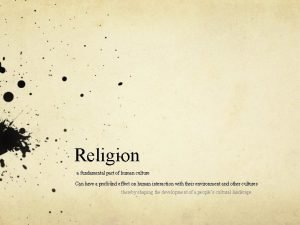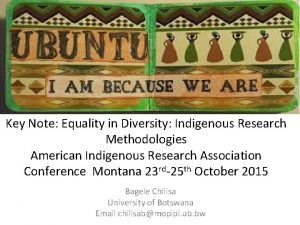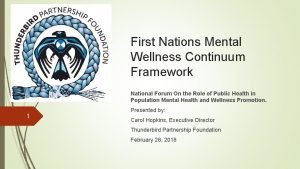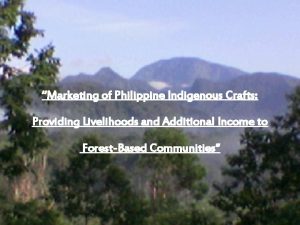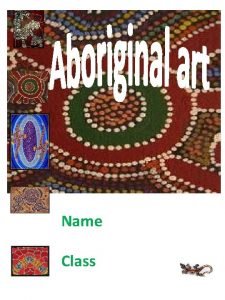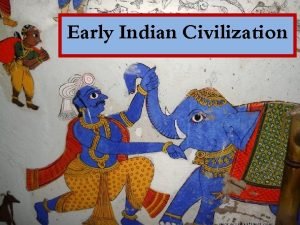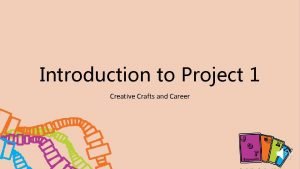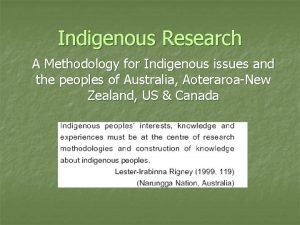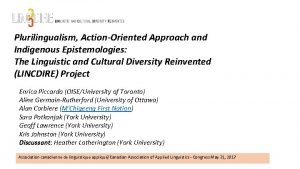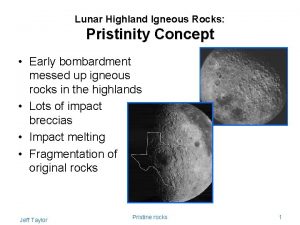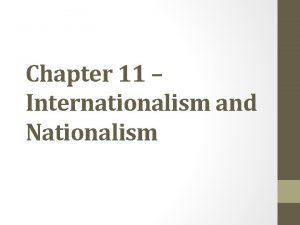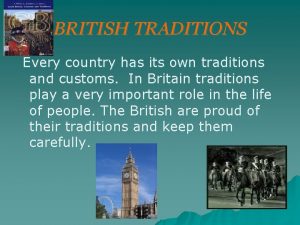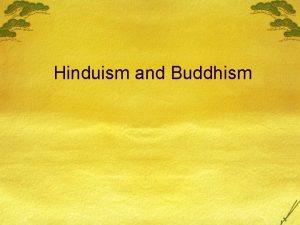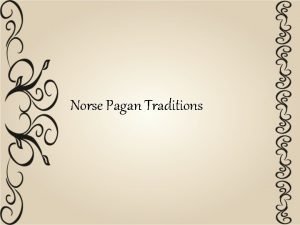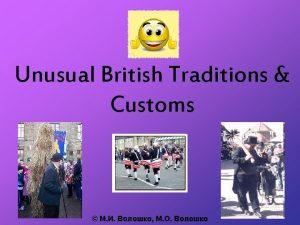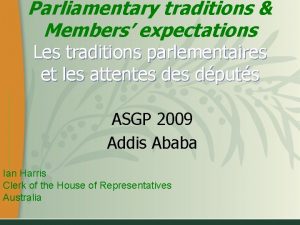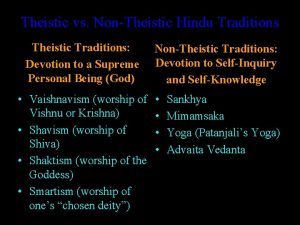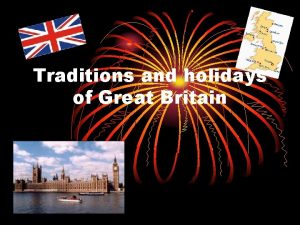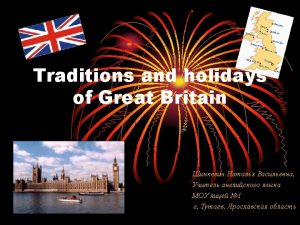Legal Issue A Indigenous Legal Traditions We want















- Slides: 15

Legal Issue A: Indigenous Legal Traditions We want firmly to root any discussion about Indigenous legal traditions in a logical starting point about the past. This starting point is broad enough to cover the diversity of Indigenous societies and does not require the reader to be Indigenous or to even have any knowledge about Indigenous peoples…Indigenous peoples lived in the place that is now called Canada, in groups, for many thousands of years. We know that Indigenous peoples did not organize themselves in “state” models of governance. We know that when groups of human beings live together, they have ways to manage themselves and all their affairs. This task of human coordination is “the most common of common denominators in law. ” (Webber) Therefore, as a matter of logic alone, our starting point has to be that, for a very long time, all Indigenous groups had self-complete, non-state systems of social ordering that were successful enough for them to continue as societies for tens of thousands of years. …We can logically assume that Indigenous legal traditions of the past, while not paragons of perfection (and no legal order is ever perfect), were reasonable legal orders managed by intelligent and reasoning people. This is our logical starting point. – Napoleon and Friedland, Roots to Renaissance at 227.

Legal Issue B: Indigenous Legal Traditions Despite the ravages of colonialism, every Indigenous nation across the country, each with its own distinctive culture and language, has kept its legal traditions and peacemaking practices alive in its communities. While Elders and Knowledge Keepers across the land have told us that there is no specific word for “reconciliation” in their own languages, there are many words, stories, and songs, as well as sacred objects such as wampum belts, peace pipes, eagle down, cedar boughs, drums, and regalia, that are used to establish relationships, repair conflicts, restore harmony, and make peace. The ceremonies and protocols of Indigenous law are still remembered and practised in many Aboriginal communities. – TRC Summary of Final Report at page 17

Legal Issue C: Indigenous Legal Traditions & Land-based Learning Legal education in North American once occurred outside the classroom. Before law schools were invented students apprenticed under the supervision of experienced practitioners. They put in long hours. They learned through observation and practice. … Of course I am talking about Indigenous legal education in North America prior to European arrival. Indigenous law was taught on the land water. Elders and other law keepers supervised their initiates in context. Demonstration, observation and practice formed the heart of learning. Lectures could occur but emphasis was given to hands-on instruction. The form and substance of legal education was based on apprenticeships. – John Borrows, Indigenous Law and Land based Learning

Legal Issue D: Doctrine of Discovery The United States Supreme Court viewed title to all land in what is now North America as rooted in the “Doctrine of Discovery. ” In a series of American decisions known as the “Marshall Decisions” in the early 1800 s, Chief Justice Marshall found that underlying title and jurisdiction in North America by the state government was based on the Doctrine of Discovery. The Doctrine of Discovery was a principle that held the ‘discovering’ European Nation held all rights to the land, before any other European Nations. The ‘discovering’ European nation claimed underlying title and jurisdiction of all the ‘discovered’ territory. The Doctrine of Discovery had no basis in International law, and has since been firmly rejected as justification for claiming territory, but the consequences remain. These consequences rely on a related concept, known as “Terra Nullius. ”

Legal Issue E There is still no widespread agreement as to whether the treaties signed between the Europeans and Indigenous peoples are to be viewed as International treaties between nations in domestic or international law. In R v Sioui, [1990] 1 SCR 1025, the Supreme Court of Canada unanimously found that the Huron Nation was the an independent sovereign nation when it negotiated a treaty with a representative of the British Crown in 1760. The court suggested all Indigenous nations held a similar status at that time. However, many state governments and courts still deny that Indigenous treaties created binding agreements under International law. As Indigenous peoples, you might wonder – if not sovereign nations, what were you viewed as? What then, did the treaties create?

Legal Issue F: The Legality and Legitimacy of Unjust Laws Law, “by its very nature. . . can turn upon us and prey upon our vulnerability” whether by “devastating the biological continuum upon which our common humanity rests” or “by subjugating the whole of life to its will. ” – F. C. Decoste, Review of Fraser, Law After Auschwitz

Legal Issue G: Human Rights and Equality of Indigenous people The early versions of the Indian Act actually made a distinction between “Indians” and “People”. South Africa studied it and used it to implement their apartheid regime. Through the Indian Act, the federal government still regulates many aspects of Aboriginal people’s lives other Canadians would never dream of. Aboriginal people living on reserves still do not receive equitable funding through the federal government for things most Canadians take for granted, such as healthy schools, proper housing and clean running water

Legal Issue H: Legislative Amendments and Statutory Interpretation/enforcement These were all laws, passed by Canadian parliament, which were added to the Indian Act as statutory amendments, until the 1950 s, when the act was amended to remove them. Status Indians were finally given the right to vote in Canada in 1960.

Legal Issue I: Enfranchisement provisions and the Charter In recent years, many strong Indigenous women have spoken out and fought this gender inequality through court cases. For example, Sharon Mc. Ivor, an Indigenous lawyer in BC, who had lost her status when she married a non-Indigenous man, pursued this in court for years. In 2009, the British Columbia Court of Appeal ruled in her favour, and found the provisions that stripped her of her status were contrary to s. 15 of the Canadian Charter of Rights and Freedoms.

Legal Issue J: First Nations Caring Society Human Rights Case Nine years ago, Advocate Cindy Blackstock and the Assembly of First Nations launched a human rights complaint, alleging Canada discriminated against Indigenous children on reserve, on the basis of their race and/or ethnic origin, by providing inequitable and insufficient funding for child welfare services on reserve, contrary to s. 5 of the Canadian Human Rights Act. In January, 2016, after years of legal battles, the Canadian Human Rights Tribunal found the complaint was made out and ordered Canada to stop its discriminatory activities and change its policies accordingly. The new government has promised not to appeal this decision and stated it is working on implementing it

Legal Issue K: National Inquiry into Missing and Murdered Indigenous Women The Inter-American Commission on Human Rights and the UN Committee on all forms of discrimination against women have both released reports about the high number of missing and murdered Indigenous women in Canada. The Native Women’s Association of Canada have led an 11 year campaign for a national inquiry into this tragic issue. On August 24 th, 2016, the federal government designated a two year National Inquiry by an Order in Council.

Legal Issue L: Using Canadian Laws to fight for Indigenous Rights and bring Change • Many Indigenous people have used Canadian law to have their rights, laws and governance recognized and respected. We have already mentioned R v Sioui, the Mc. Ivor case, and the First Nation Child and Family Caring Society human rights complaint. To give few more examples: • Calder v. BC (1973): The was the first case where a Canadian court acknowledged that Aboriginal Title to land existed prior to colonization and prior to the Royal Proclamation of 1763. This case opened the door to negotiations to Canadian and First Nations governments about lands and rights. 27 years of negotiation later, in 2000, the Nisga’a people who brought this case signed the first modern land claim agreement. • R v. Sparrow (1982): This was the first Supreme Court case that explained what Aboriginal rights in s. 35 (1) of the Constitution Act are and how to recognize them (and, infringe upon them). • Delgamuukw v. British Columbia (1997): Hereditary chiefs from the Gitxsan and Wet'suwet'en First Nations brought this case. Although the Supreme Court never decided the question before them, they described what Aboriginal Title is and established the Canadian government has a duty to consult with First Nations. • Haida (2004) and Mikisew Cree (2005): In these two cases about the duty to consult, Supreme Court ruled that federal and provincial governments must act in good faith and meaningfully consult with First Nations in cases of unproven claims (Haida) and in cases of historical treaties (Mikisew Cree), in order to uphold the “Honour of the Crown. ” • Tsilhqot’in Case (2014): For the first time in Canada, the Supreme Court made a declaration of Aboriginal Title includes the right to govern and manage the lands in question.

Legal Issue M: Law’s Legitimacy and Reconciliation In Canada, law must cease to be a tool for the dispossession and dismantling of Aboriginal societies. It must dramatically change if it is going to have any legitimacy within First Nations, Inuit, and Métis communities. Until Canadian law becomes an instrument supporting Aboriginal peoples’ empowerment, many Aboriginal people will continue to regard it as a morally and politically malignant force. A commitment to truth and reconciliation demands that Canada’s legal system be transformed. It must ensure that Aboriginal peoples have greater ownership of, participation in, and access to its central driving forces. Canada’s Constitution must become truly a constitution for all of Canada. Aboriginal peoples need to become the law’s architects and interpreters where it applies to their collective rights and interests. Aboriginal peoples need to have more formal influence on national legal matters to advance and realize their diverse goals. TRC Summary of the Final Report at 205

Legal Issue N: Indigenous Laws in Canadian Law From as early as 1867, in the case, Connolly v. Woolrich, Canadian courts recognized that there were other legal systems in Canada pre-dating the arrival of the common law. Campbell v. BC AG (2000) recognized Indigenous peoples have a continued right of self-government that was not extinguished by Canada’s constitution or subsequent legislation. Indigenous laws are part of Canadian constitutional and common-law. Chief Justice Beverley Mc. Lachlin has stated that access to Indigenous laws is an access to justice measure, and we need concepts of Indigenous justice and the legal processes of achieving justice at the “Canadian justice table”. Chief Justice Beverley Mc. Lachlin, Keynote Address (delivered at the Canadian Institute for the Administration of Justice 2015 Annual Conference, Aboriginal Peoples and Law: ‘We Are All Here to Stay’, Saskatoon, 16 October 2015) [unpublished].

Legal Topic O: Indigenous Laws and Reconciliation Aboriginal peoples must be recognized as possessing the responsibility, authority, and capability to address their disagreements by making laws within their communities. This is necessary to facilitating truth and reconciliation within Aboriginal societies. TRC Summary of the Final Report at 205.
 Simple machines used by first nations
Simple machines used by first nations The world's largest universalizing religion is
The world's largest universalizing religion is What is indigenous research
What is indigenous research First nations mental wellness continuum framework
First nations mental wellness continuum framework It is an indigenous dance from a certain race or country. *
It is an indigenous dance from a certain race or country. * Examples of indigenous crafts in the philippines
Examples of indigenous crafts in the philippines Aborginal symbols
Aborginal symbols Indigenous aryans
Indigenous aryans Introduction to indigenous creative crafts
Introduction to indigenous creative crafts Indigenous axiology
Indigenous axiology Primal indigenous religion ap human geography
Primal indigenous religion ap human geography Defenition of bacteria
Defenition of bacteria Indigenous methodologies
Indigenous methodologies Lite lincdire project
Lite lincdire project Pristinity
Pristinity World council of indigenous peoples
World council of indigenous peoples

